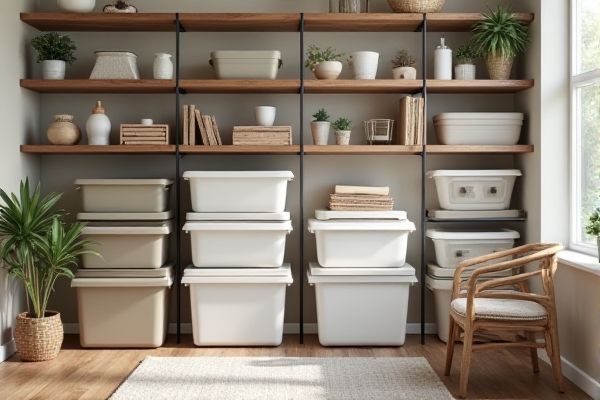
Stackable bins provide a stable, space-saving solution by securely piling on top of each other, ideal for organizing and maximizing vertical storage. If you want to discover which option best suits your storage needs, continue reading our detailed comparison of stackable bins versus nestable bins.
Table of Comparison
| Feature | Stackable Bins | Nestable Bins |
|---|---|---|
| Design | Rigid sides, flat bottoms for stable stacking | Tapered sides for nesting inside each other |
| Storage Efficiency | Maximizes vertical space when filled | Maximizes space when empty, nesting reduces volume |
| Material Usage | Typically uses thicker plastic for strength | Uses less plastic due to tapered design |
| Weight Capacity | Higher weight capacity for stacked loads | Moderate weight capacity, less suited for heavy stacking |
| Cost | Generally higher due to material and design | More cost-effective because of less material usage |
| Common Uses | Warehousing, transport, and long-term storage | Temporary storage, transport, and space-saving |
| Durability | Highly durable with reinforced structure | Durable but less reinforced for heavy loads |
| Handling | Stack securely, easier for palletizing | Compact when empty, requires un-nesting before use |
Introduction to Stackable and Nestable Bins
Stackable bins are designed with sturdy, flat lids or reinforced edges that allow secure piling, maximizing vertical storage space without compromising accessibility. Nestable bins feature tapered sides enabling them to fit inside one another when empty, significantly reducing storage volume and saving floor space. Your choice depends on whether you prioritize efficient use of storage height or minimizing empty storage footprint.
Key Differences Between Stackable and Nestable Bins
Stackable bins are designed with flat tops and reinforced corners, allowing them to be securely stacked one on top of another, maximizing vertical storage space. Nestable bins feature tapered sides that enable them to fit inside each other when empty, saving floor space during storage or transport. Key differences include stackable bins' stability when loaded versus nestable bins' space efficiency when empty, making each suitable for different warehouse organization needs.
Space Efficiency: Stackable vs Nestable Bins
Stackable bins maximize vertical space by securely stacking on top of each other without collapsing, making them ideal for organized storage in warehouses or workshops. Nestable bins save floor space when empty by fitting inside one another, reducing storage volume by up to 70%, which is beneficial during transport or when not in use. Choosing stackable bins enhances space efficiency during use, while nestable bins optimize space efficiency during storage and transportation.
Material and Durability Comparison
Stackable bins are typically made from heavy-duty plastic or metal, designed to withstand higher weight loads and rough handling without cracking or deforming. Nestable bins, often constructed from lighter plastic materials, prioritize space-saving by fitting inside each other but may sacrifice some durability under heavy use or impact. For your storage needs, choosing stackable bins ensures longer-lasting strength in demanding environments, while nestable bins offer efficient storage with moderate durability.
Load Capacity and Weight Considerations
Stackable bins typically offer higher load capacity due to reinforced edges and uniform stacking surfaces that distribute weight evenly, making them ideal for heavy-duty storage and transportation. Nestable bins save space when empty by fitting inside one another but generally have lower weight tolerance because their design prioritizes compact nesting over structural strength. Choosing between the two depends on balancing the need for maximum load capacity versus efficient storage space during non-use.
Applications and Industry Usage
Stackable bins are widely used in industries requiring efficient space utilization in vertical storage, such as automotive manufacturing, electronics assembly, and retail distribution centers. Nestable bins find their application in industries prioritizing savings in return logistics and storage space when empty, including agriculture, food processing, and pharmaceutical sectors. Both bin types optimize workflow and inventory management but are selected based on specific operational needs like space constraints and transport efficiency.
Storage and Handling Flexibility
Stackable bins provide enhanced storage density by allowing secure vertical stacking, maximizing space efficiency in warehouses and transport. Nestable bins fold into each other when empty, reducing storage footprint and lowering return transportation costs. Your choice between stackable and nestable bins depends on whether you prioritize space-saving during storage or optimized stackability during handling.
Cost Comparison: Stackable vs Nestable Bins
Stackable bins typically incur higher costs due to their reinforced design that supports weight when stacked, making them ideal for heavy-duty storage needs. Nestable bins, on the other hand, offer cost savings by nesting inside one another when empty, reducing transportation and storage expenses significantly. Your choice between stackable and nestable bins should consider the balance between upfront investment and long-term savings in handling and storage efficiency.
Safety and Accessibility Features
Stackable bins offer enhanced safety with sturdy construction and secure stacking design that prevents accidental toppling in warehouse and industrial environments. Nestable bins improve accessibility by allowing easy nesting within each other, saving space and enabling faster retrieval without compromising structural integrity. Both types often include ergonomic handles and reinforced edges, ensuring user safety and efficient material handling.
Choosing the Right Bin for Your Needs
Choosing the right bin depends on your storage goals and space constraints; stackable bins maximize vertical storage efficiency by securely piling bins without collapsing, ideal for warehouses with limited floor space. Nestable bins reduce storage volume when empty by allowing bins to fit inside one another, saving transport and storage costs in operations where bins are frequently returned empty. Considering bin material, load capacity, and handling ease will further optimize your choice between stackable and nestable bins.
 homyna.com
homyna.com